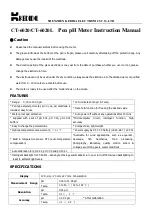
overload for readings greater than 120% of range. Overload only occurs when the algorithm times out
because the applied capacitance is too large for the algorithm to measure. If you apply a DC voltage or
a short to the input terminals in capacitance measurement mode, the instrument reports an overload.
l
ONCE performs an immediate autorange, and then sets autoranging to OFF. (Thus, the query returns
"0".)
l
Selecting a discrete range (see
command) disables autoranging.
l
This parameter is set to its default value after a Factory Reset (
) or Instrument Preset
(
).
[SENSe:]CAPacitance:RANGe {<
range
>|MIN|MAX|DEF}
[SENSe:]CAPacitance:RANGe? [{MIN|MAX|DEF}]
Selects a fixed range for capacitance measurements.
Parameter
Typical Return
<
range
>: {1 nF|10 nF|100 nF|1 µF|10 µF|100 µF}.
Default: AUTO.
+1.00000000E-09
Configure capacitance measurements, select 1 nF range, turn null function on, use the AUTO null function.
Make two measurements and send them to the instrument's output buffer:
CONF:CAP
CAP:RANG 1 nF
or
CAP:RANG 1.0E-9
CAP:NULL ON
CAP:NULL:VAL:AUTO ON
SAMP:COUN 2
READ?
Typical Response: +3.01963841E-10,+3.01566277E-10
l
Selecting a fixed range ([SENSe:]<function>:RANGe) disables autoranging.
l
If the input signal is greater than can be measured on the specified fixed range, the instrument displays
Overload
on front panel and returns "9.9E37" from the remote interface.
l
This parameter is set to its default value after a Factory Reset (
) or Instrument Preset
(
).
Keysight True
volt
Series Operating and Service Guide
317
SCPI Programming Reference
















































